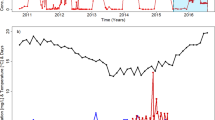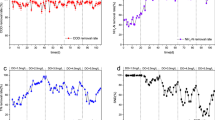Abstract
This study evaluates changes in the microbial community structure and function of a pilot-scale denitrifying fluidized bed reactor during periods of constant operating conditions and periods of perturbation. The perturbations consisted of a shutdown period without feed, two disturbances in which biofilms were mechanically sheared from carrier particles, and a twofold step increase in feed nitrate concentration. In the absence of perturbations, nitrate removal was stable and consistently greater than 99%. The structure and dynamics of the microbial community were studied using cloning and sequencing techniques and terminal restriction fragment length polymorphism (T-RFLP) of the SSU rRNA gene. Under unperturbed operating conditions, stable function was accompanied by high constancy and low variability of community structure with the majority of terminal restriction fragments (T-RFs) appearing throughout operation at consistent relative abundances. Several of the consistently present T-RFs correlated with clone sequences closely related to Acidovorax (98% similarity), Dechloromonas (99% similarity), and Zoogloea (98% similarity), genera recently identified by molecular analyses of similar systems. Significant changes in community structure and function were not observed after the shutdown period. In contrast, following the increase in loading rate and the mechanical disturbances, new T-RFs appeared. After both mechanical disturbances, function and community structure recovered. However, function was much more resilient than community structure. The similarity of response to the mechanical disturbances despite differences in community structure and operating conditions suggests that flexible community structure and potentially the activity of minor members under nonperturbation conditions promotes system recovery.





Similar content being viewed by others
References
Amann, R, Ludwig, W, Schulze, R, Spring, S, Moore, E, Schleifer, KH (1996) rRNA-targeted oligonucleotide probes for the identification of genuine and former pseudomonads. Syst Appl Microbiol 19: 501–509
Briones, A, Raskin, L (2003) Diversity and dynamics of microbial communities in engineered environments and their implications for process stability. Curr Opin Biotechnol 14: 270–276
Cole, JR, Chai, B, Marsh, TL, Farris, RJ, Wang, Q, Kulam, SA, Chandra, S, Mcgarrell, DM, Schmidt, TM, Garrity, GM, Tiedje, JM (2003) The ribosomal database project (RDP-II): previewing a new autoaligner that allows regular updates and the new prokaryotic taxonomy. Nucleic Acids Res 31: 442–443
Colwell, RK (2004) EstimateS: Statistical Estimation of Species Richness and Shared Species from Samples. Version 7 [Online.]. User's guide and application available at: http://Purl.Oclc.Org/Estimates
Crosby, LD, Criddle, CS (2003) Understanding bias in microbial community analysis techniques due to rrn operon copy number heterogeneity. Biotechniques 34: 790–802
Curtis, T, Head, I, Graham, D (2003) Theoretical ecology for engineering biology. Environ Sci Technol 37: 64A–70A
Doak, DF, Bigger, D, Harding, EK, Marvier, MA, O'Malley, RE, Thomson, D (1998) The statistical inevitability of stability–diversity relationships in community ecology. Am Natural 151: 264–276
Dunbar, J, Ticknor, L, Kuske, C (2000) Assessment of microbial diversity in four southwestern United States soils by 16S rRNA gene terminal restriction fragment analysis. Appl Environ Microbiol 66: 2943–2950
Egert, M, Friedrich, M (2003) Formation of pseudo-terminal restriction fragments, a PCR-related bias affecting terminal restriction fragment length polymorphism analysis of microbial community structure. Appl Environ Microbiol 69: 2555–2562
Etchebehere, C, Errazquin, I, Barrandeguy, E, Dabert, P, Moletta, L, Muxi, L (2001) Evaluation of the denitrifying microbiota of anoxic reactors. FEMS Microbiol Ecol 35: 259–265
Etchebehere, C, Errazquin, M, Dabert, P, Muxi, L (2002) Community analysis of a denitrifying reactor treating landfill leachate. FEMS Microbiol Ecol 40: 97–106
Fernandez, A, Huang, SY, Seston, S, Xing, J, Hickey, R, Criddle, C, Tiedje, J (1999) How stable is stable? Function versus community composition. Appl Environ Microbiol 65: 3697–3704
Fernandez, AS, Hashsham, SA, Dollhopf, SL, Raskin, L, Glagoleva, O, Dazzo, O, Hickey, RF, Criddle, CS, Tiedje, JM (2000) Flexible community structure correlates with stable community function in methanogenic bioreactor communities perturbed by glucose. Appl Environ Microbiol 66: 4058–4067
Fields, MW, Yan, T, Rhee, S-K, Carroll, SL, Jardine, PM, Watson, DB, Criddle, DB, Zhou, J (2005) Impacts on microbial communities and cultivable isolates from groundwater contaminated with high levels of nitric acid–uranium waste. FEMS Microbiol Ecol 53: 417–428
Godon, JJ, Zumstein, E, Dabert, P, Habouzit, F, Moletta, R (1997) Molecular microbial diversity of an anaerobic digestor as determined by small-subunit rDNA sequence analysis. Appl Environ Microbiol 63: 2802–2813
Grimm, V, Schmidt, E, Wissel, C (1992) On the application of stability concepts in ecology. Ecol Model 63: 143–161
Hashsham, S, Fernandez, A, Dollhopf, S, Dazzo, F, Hickey, R, Tiedje, J, Criddle, J (2000) Parallel processing of substrate correlates with greater functional stability in methanogenic bioreactor communities perturbed by glucose. Appl Environ Microbiol 66: 4050–4057
Hiscock, K, Lloyd, J, Lerner, D (1991) Review of natural and artificial denitrification of groundwater. Water Res 25: 1099–1111
http://www.esd.ornl.gov/Nabirfrc/. Cited November 19, 2004
Hurt, RA, Qiu, XY, Wu, LY, Roh, Y, Palumbo, AV, Tiedje, JM, Zhou, JH (2001) Simultaneous recovery of RNA and DNA from soils and sediments. Appl Environ Microbiol 67: 4495–4503
Janda, V, Rudovsky, J, Wanner, J, Marha, K (1988) In situ denitrification of drinking-water. Water Sci Technol 20: 215–219
Kaplan, C, Kitts, C (2003) Variation between observed and true terminal restriction fragment length is dependent on true TRF length and purine content. J Microbiol Methods 54: 121–125
Kaplan, CW, Astaire, JC, Sanders, ME, Reddy, BS, Kitts, CL (2001) 16S ribosomal DNA terminal restriction fragment pattern analysis of bacterial communities in feces of rats fed lactobacillus acidophilus NCFM. Appl Environ Microbiol 67: 1935–1939
Labbe, N, Juteau, P, Parent, S, Villemur, R (2003) Bacterial diversity in a marine methanol-fed denitrification reactor at the Montreal Biodome, Canada. Microbial Ecol 46: 12–21
Lane, D (1991) 16S/23s rRNA sequencing. In: Stackebrant E, Goodfellow M (Eds.) Nucleic Acid Techniques in Bacterial Systematics. Wiley, New York, pp 115–175
Lee, H, Lee, S, Lee, J, Park, J, Choi, E, Park, Y (2002) Molecular characterization of microbial community in nitrate-removing activated sludge. FEMS Microbiol Ecol 41: 85–94
Lehman, CL, Tilman, D (2000) Biodiversity, stability, and productivity in competitive communities. Am Nat 156: 534–552
Loreau, M, Naeem, S, Inchausti, P, Bengtsson, J, Grime, J, Hector, A, Hooper, A, Huston, M, Raffaelli, D, Schmid, B, Tilman, D, Wardle, D (2001) Ecology—biodiversity and ecosystem functioning: current knowledge and future challenges. Science 294: 804–808
Ludwig, W, Strunk, O, Westram, R, Richter, L, Meier, H, Kumar, Y, Buchner, A, Lai, T, Steppi, S, Jobb, G, Forster, W, Brettske, W, Gerber, S, Ginhart, AW, Gross, O, Grumann, S, Hermann, S, Jost, R, Konig, A, Liss, T, Lussmann, R, May, M, Nonhoff, B, Reichel, B, Strehlow, R, Stamatakis, A, Stuckmann, N, Vilbig, A, Lenke, M, Ludwig, T, Bode, A, Schleifer, KH (2004) ARB: a software environment for sequence data. Nucleic Acids Res 32: 1363–1371
Mcnaughton, SJ (1977) Diversity and stability of ecological communities a comment on the role of empiricism in ecology. Am Nat 111: 515–525
Neubert, M, Caswell, H (1997) Alternatives to resilience for measuring the responses of ecological systems to perturbations. Ecology 78: 653–665
Pimm, S (1984) The complexity and stability of ecosystems. Nature 307: 321–326
Qiu, XY, Wu, LY, Huang, HS, McDonel, PE, Palumbo, AV, Tiedje, JM, Zhou, JM (2001) Evaluation of PCR-generated chimeras: mutations, and heteroduplexes with 16S rRNA gene-based cloning. Appl Environ Microbiol 67: 880–887
Schulze, R, Spring, S, Amann, R, Huber, I, Ludwig, W, Schleifer, KH, Kampfer, KH (1999) Genotypic diversity of acidovorax strains isolated from activated sludge and description of Acidovorax defluvii sp nov. Syst Appl Microbiol 22: 205–214
Smith, N, Yu, Z, Mohn, W (2003) Stability of the bacterial community in a pulp mill effluent treatment system during normal operation and a system shutdown. Water Res 37: 4873–4884
Smith, R, Miller, D, Brooks, M, Widdowson, M, Killingstad, M (2001) In situ stimulation of groundwater denitrification with formate to remediate nitrate contamination. Environ Sci Technol 35: 196–203
Son, K, Hall, E (2003) Use of a similarity index based on microbial fatty acid (MFA) analysis to monitor biological wastewater treatment systems. Environ Technol 24: 1147–1156
Song, BK, Palleroni, NJ, Haggblom, MM (2000) Isolation and characterization of diverse halobenzoate-degrading denitrifying bacteria from soils and sediments. Appl Environ Microbiol 66: 3446–3453
Stamper, D, Walch, M, Jacobs, R (2003) Bacterial population changes in a membrane bioreactor for graywater treatment monitored by denaturing gradient gel electrophoretic analysis of 16S rRNA gene fragments. Appl Environ Microbiol 69: 852–860
Sundh, I, Carlsson, H, Nordberg, A, Hansson, M, Mathisen, B (2003) Effects of glucose overloading on microbial community structure and biogas production in a laboratory-scale anaerobic digester. Bioresour Technol 89: 237–243
Thioulouse, J, Chessel, D, Doledec, S, Olivier, J-M (1997) Ade-4: a multivariate analysis and graphical display software. Stat Comput 7: 75–83
Tilman, D (1996) Biodiversity: population versus ecosystem stability. Ecology 77: 350–363
Tilman, D (1999) The ecological consequences of changes in biodiversity: a search for general principles. Ecology 80: 1455–1474
Von Canstein, H, Li, Y, Felske, A, Wagner-Dobler, I (2001) Long-term stability of mercury-reducing microbial biofilm communities analyzed by 16S-23s rDNA interspacer region polymorphism. Microbial Ecol 42: 624–634
Wang, CC, Lee, CM (2001) Denitrification with acrylonitrile as a substrate using pure bacteria cultures isolated from acrylonitrile–butadiene–styrene wastewater. Environ Int 26: 237–241
Yoshie, S, Noda, N, Miyano, T, Tsuneda, S, Hirata, A, Inamori, Y (2001) Microbial community analysis in the denitrification process of saline-wastewater by denaturing gradient gel electrophoresis of PCR-amplified 16S rDNA and the cultivation method. J Biosci Bioeng 92: 346–353
Zhou, JZ, Bruns, MA, Tiedje, JM (1996) DNA recovery from soils of diverse composition. Appl Environ Microbiol 62: 316–322
Zumstein, E, Moletta, R, Godon, JJ (2000) Examination of two years of community dynamics in an anaerobic bioreactor using fluorescence polymerase chain reaction (PCR) single-strand conformation polymorphism analysis. Environ Microbiol 2: 69–78
Acknowledgments
We thank Qi Ye for assistance in 16S rRNA sequencing of bacterial isolates. This research was supported by the Natural and Accelerated Bioremediation Research program, Biological and Environmental Research, U.S. Department of Energy under grant number DE-F603-00ER63046. Margaret Gentile was supported by a Stanford Graduate Fellowship sponsored by James Clark and a fellowship from the U.S. Environmental Protection Agency Science to Achieve Results program.
Author information
Authors and Affiliations
Corresponding author
Rights and permissions
About this article
Cite this article
Gentile, M., Yan, T., Tiquia, S.M. et al. Stability in a Denitrifying Fluidized Bed Reactor. Microb Ecol 52, 311–321 (2006). https://doi.org/10.1007/s00248-006-9024-1
Received:
Accepted:
Published:
Issue Date:
DOI: https://doi.org/10.1007/s00248-006-9024-1




